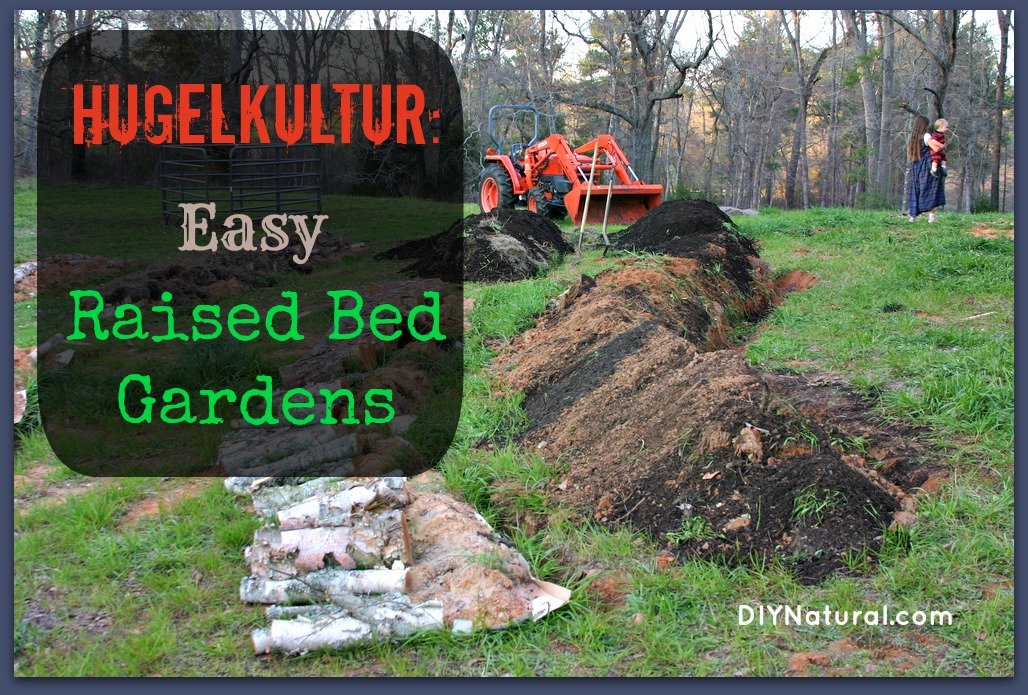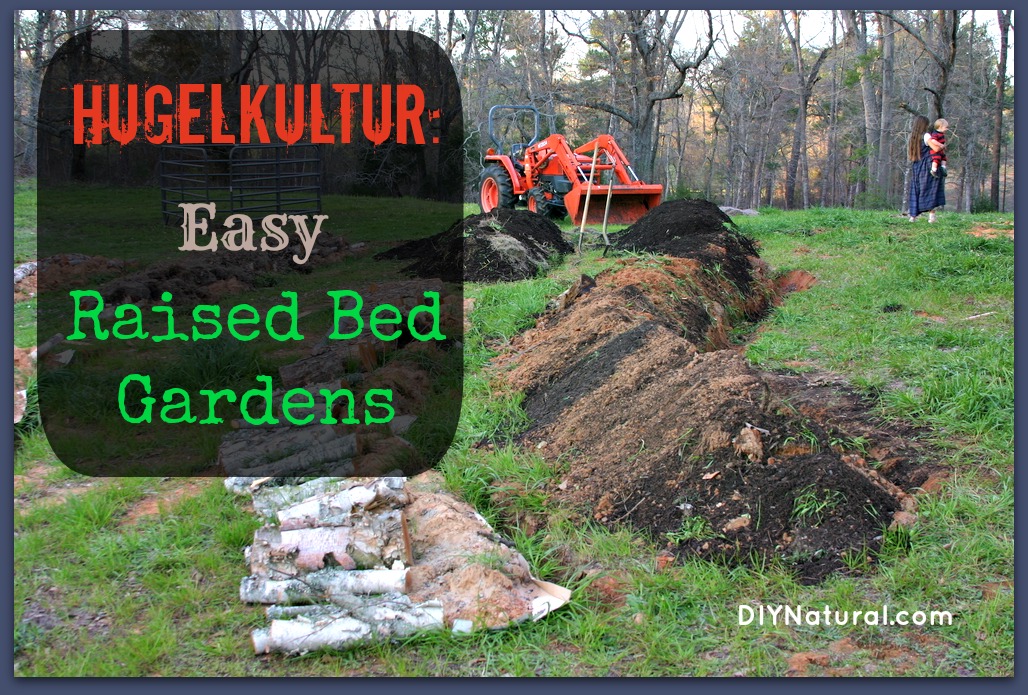
Hugelkultur is German for “Raised Garden Beds” or “Hill Culture” and it’s essentially making raised garden beds using wood logs as a base.
A few weeks ago I wrote an article on biochar, a centuries old technique for adding nutrients to the soil and retaining them. This article generated a comment that mentioned hugelkultur. What I read was intriguing, so I researched it and found that I wanted to learn more. Much more!
Hugelkultur is essentially making raised garden beds using wood logs as a base. The word hugelkultur translates to “hill culture.” You add soil to the top and leave it to do what it does naturally. The microbes in the soil start to break the wood down and add nutrients to the soil. The wood composts under the soil, retaining water and nitrogen. After the first year, it becomes self-tilling, so you only need to plant, harvest and enjoy. Sound simple? It really is.
How to build hugelkultur beds
Start with a pile of wood. Lay it out where you would like your garden bed to be. Add more wood until it is about six feet tall. You can go shorter to begin with, but taller is better since it will break down over time. Also, you can dig it into the ground to create a pit effect, but above ground is better. You can build the beds anywhere, but full sun is optimal. When you get the logs where you want, add a layer of soil to the top. This may be a good time to water the entire thing. Add fertilizer if you wish at this point. I mix my manure with soil and compost and use this to put on top.
Plants can then be planted along the sides. You may need to fertilize and water at first, but as the wood breaks down, it’ll become less and less necessary. (Click here for more images of hugelkultur beds.)
How hugelkultur works
Over time, the wood breaks down, creating air space for microbes to colonize and nutrients to hide out in. Using biochar in addition to the soil would maximize your soil capacity. After the first year, it should break down enough that you don’t need to do anything other than plant your plants. It becomes self-tilling, making the soil more and more usable. This method lasts for years, so you don’t need to till and weed every year. The mounds do get some weeds at first, but they are easy to pull out since there is a slope on the sides.
Sustainable raised bed gardening
Hugelkultur may be a funny sounding name, but its benefits are no joke. Some benefits of hugelkultur include the following:
- After established, they require no fertilizer or irrigation.
- It works anywhere, from the rain forest to the desert.
- The raised mounds are great for gardeners with mobility issues.
- It could provide poor countries with a means to produce massive quantities of food.
- You can use twigs, branches and logs. It all becomes buried wood.
- It can be built in-ground, but above-ground is best.
- You can start small and go bigger later.
- You can stick with smaller mounds.
- It sequesters carbon in the ground, not adding to greenhouse gasses.
- Hugelkultur allows you to take advantage of downed trees.
- All of the nutrients produced are organic.
- Air pockets are produced for microbes and worms.
- Speaking of worms, vermiculture can be easily added.
- It’s self-tilling.
- It holds massive amounts of water without rotting roots. The wood acts like a sponge as it breaks down, holding lots of water.
- Fungi, such as mycorrhizae, are beneficial to the soil. Fungi colonize rapidly in decaying wood.
The right wood for hugelkultur
While almost any wood can be used, you want to stay away from cedar and walnut. They have resins and toxins that aren’t good for plant life. Cherry can be toxic to animals, so it’s not a good choice either. Locust should also be avoided because it’s very slow to break down. Some of the better woods are apple, alder, cottonwood, birch, willow and poplar. Pine is ok, but as it first breaks down, it will suck nitrogen out of the soil in large amounts. Knowing this, you can add extra nitrogen for the first few years. (Find nitrogen-rich blood meal here.) After it breaks down enough, it starts giving nitrogen back. Do a soil test occasionally so you know what the exact conditions are. (Find soil testing kits here.)
Hugelkultur is an old way of gardening, but it’s new to us here in the USA. Folks have been using this method for a long time, but the applications remain the same. It’s an easy way to create a raised bed that you’ll enjoy for years. Self maintaining and stabilizing, hugelkultur seems to be the way to go.
*******




We tried hugelkultur for the first time this year. Our hill is around 3 feet tall, but that seemed fine to start this year. I’m in the process of starting a new “regular” raised bed for some perennial plants that need to be contained and plan to start it with a nice layer of wood. I figure it should act in a similar way at the bottom of a container and at the bottom of a hill. Then I can build it up the same as for a hugelkultur bed. Wondering if anyone has tried that?
A friend recently recommended that I check out a short film on YouTube called The back to Eden gardening method. It has lots in common with hugelkultur but may be even less labor intensive with amazing results. It’s definetly worth a look. I’m curious to know if anyone else has heard about this method and what they think
Laura.. Yes! I watched the Back To Eden film online a few months ago, and got really excited. It – and this too – makes total sense: the forest floor is always self-composting, you can’t STOP things from growing from it. Using the methods God built into nature is just common sense.
hi! i love this idea. my husband and i watched Back to Eden and have used a small version of it in our flower bed. i can’t believe it works but it does. we put about 5 inches of shredded bark over the beds and we don’t have to water. granted we don’t have super hot summers, but still, when i go check to see how everything is fairing and move back the bark to check on the moisture level it looks like we just watered. we started this last year & i still can’t believe it works! lol 🙂 i definitely want to give hugelkultur a try. i love the idea and with health issues it would make it easier to garden if i didn’t have to crawl all over the yard! thanks so much!
We’ve been building our beds using hugelkultur principles. We’ve got a lot of poplars on our block which we are chopping down but being such a soft wood they’re not great for burning in large quantities so we were stoked to fnd them great for hugelkultur beds. We won’t be stacking 6ft high but I’m hoping for around 2-3 foot at least. Currently we have all our standard raised beds with the bottom 3rd packed with the lightweight brances and some heavier logs which helped clear up the block nicely.
Rebeca, contact your local council to see if they have branches and trees they’ve chopped down that you could have. They won’t be half rotting now but covered in damp soil they will be before long. Just add extra nitrogen and plant them with low nitrogen requiring plants the first year. Pumpkins and squash are supposed to grow very well on hugelkultur beds. 🙂
Since I live in the city where should I get these half dying logs?
Contact your city works department. Often they will letb you take logs after they’ve trimmed trees or dealt with storm damage. Or you can put the word out to neighbors and friends.
Did you really mean for us to stack the wood six feet tall? If so, can you provide an illustration?
Thanks!
You don’t need to go six feet, and it will break down over time. Even a few feet tall is better than on flat ground. There are links above to see some examples and how it’s done.